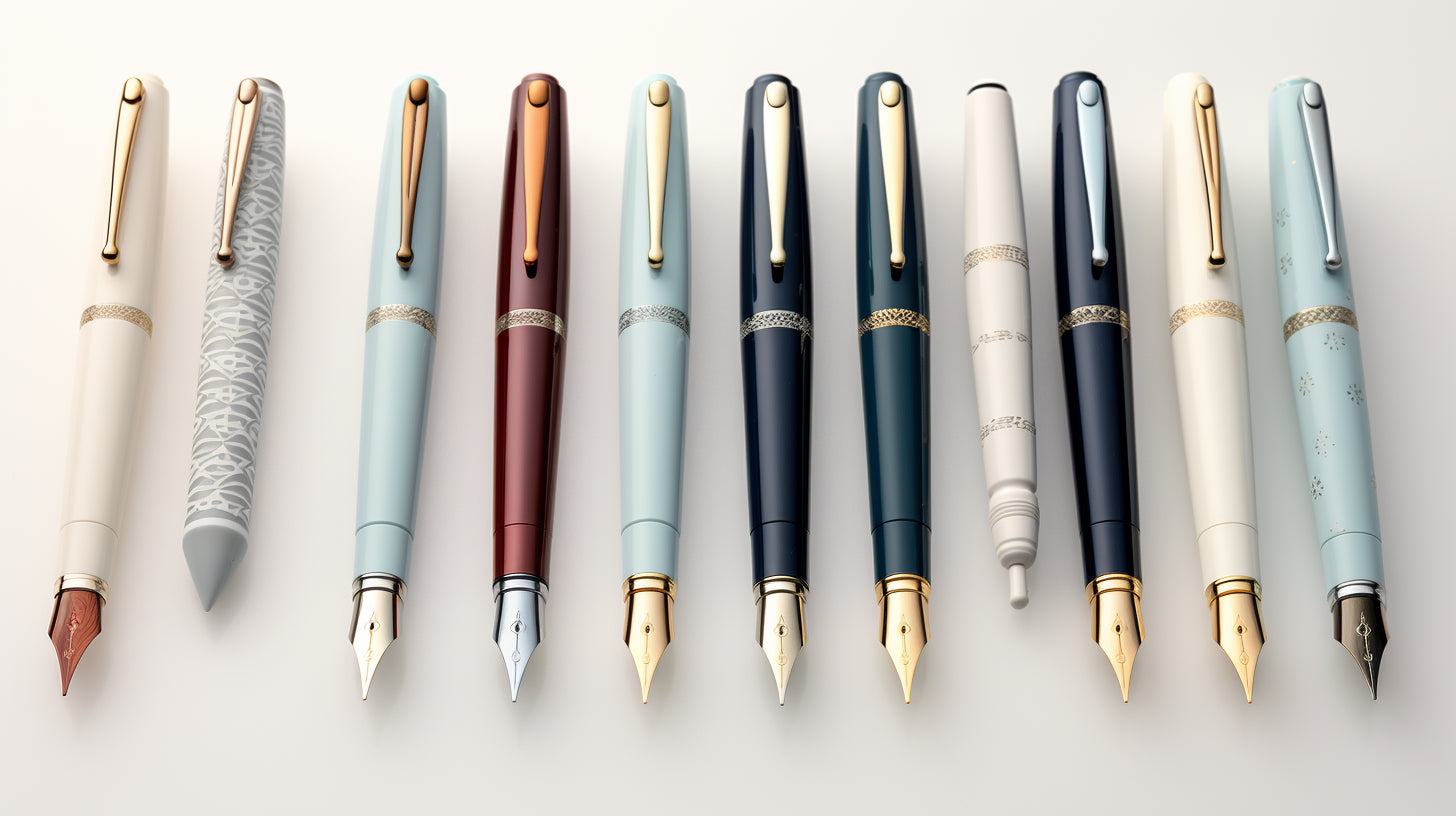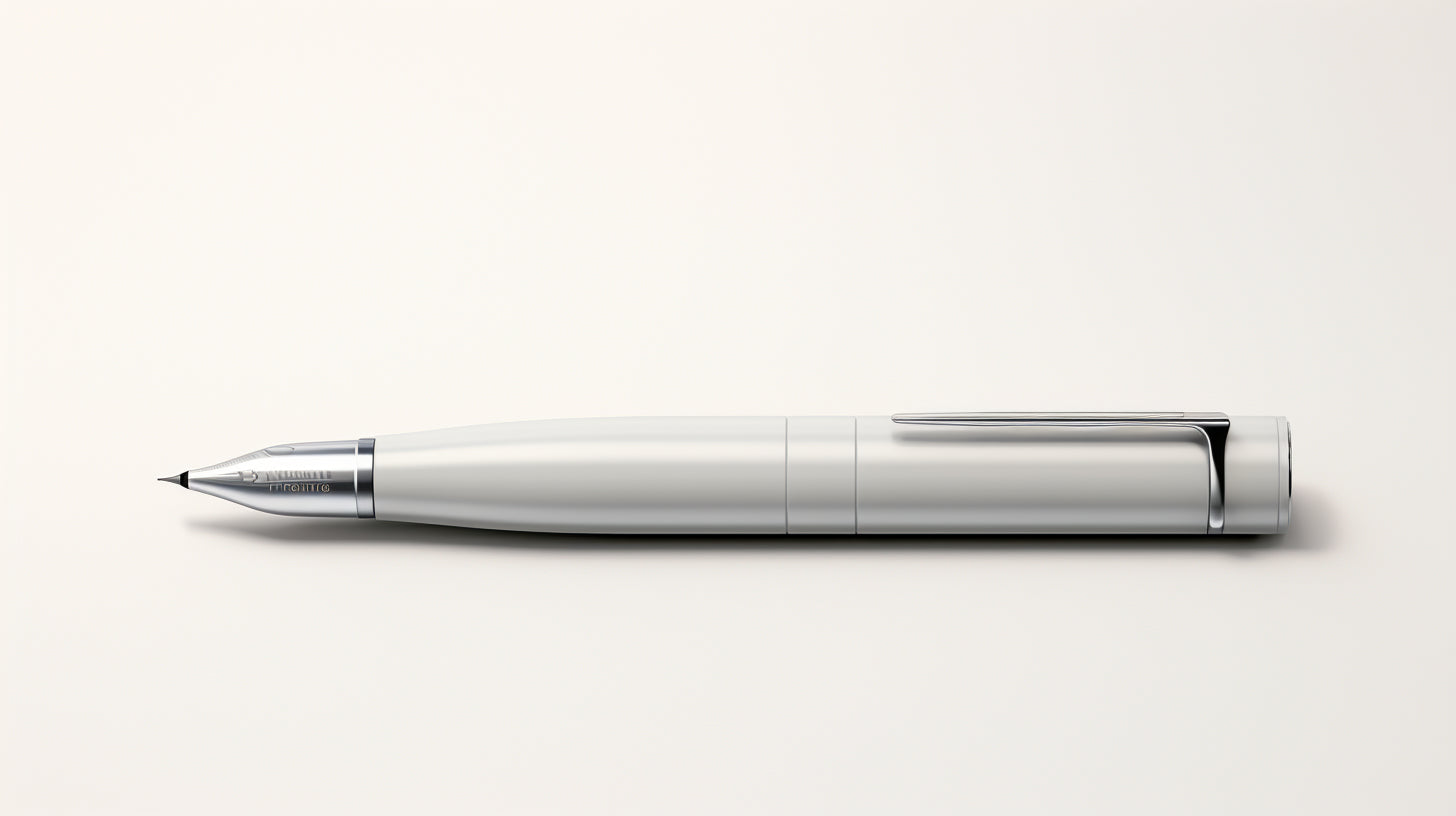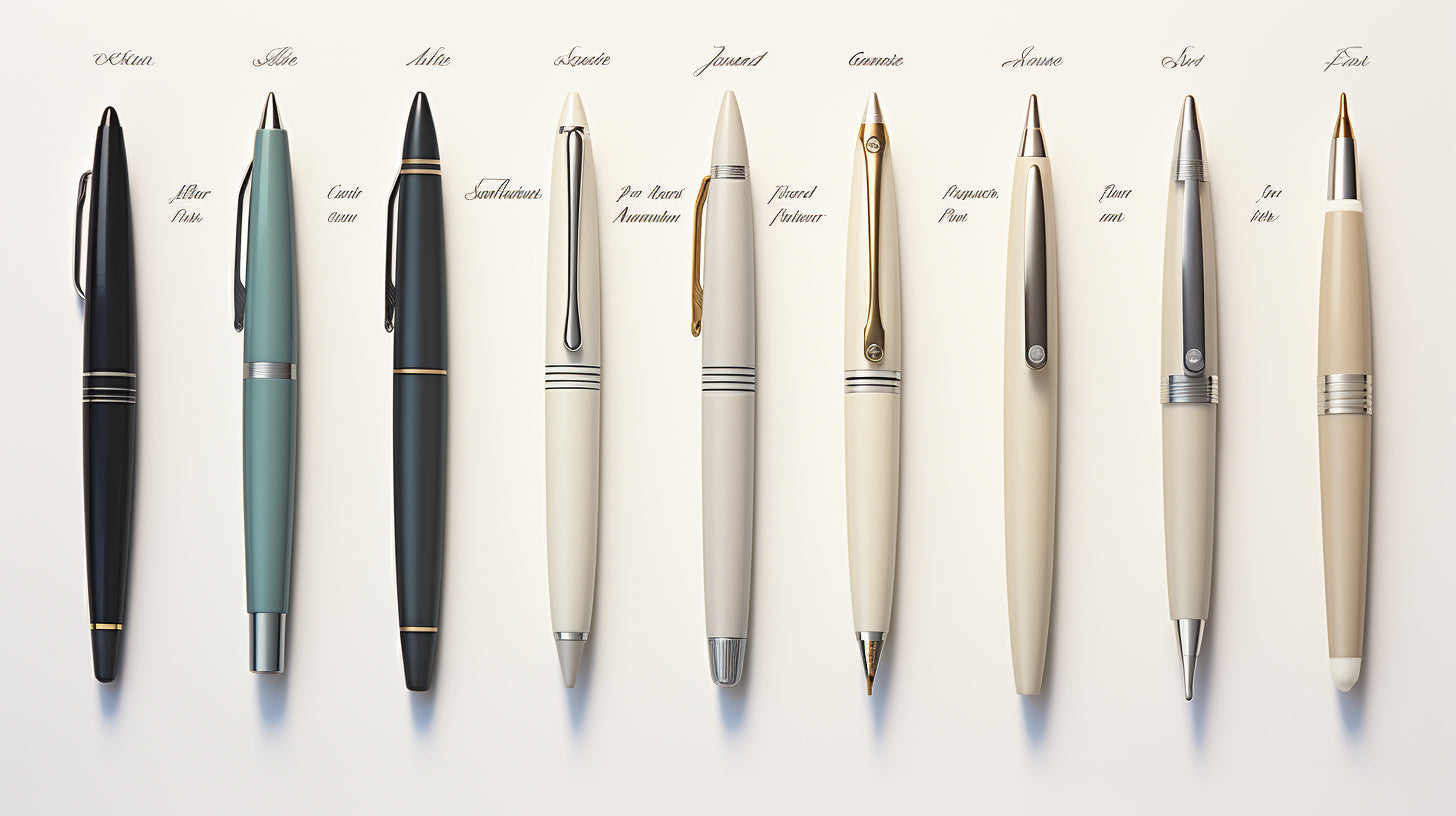
Find Your Signature Pen: Tips for Selecting a Fountain Pen that's Truly Yours
Are you tired of using the same old ballpoint pen for your writing needs? Looking to add a touch of elegance and sophistication to your writing experience? Well, it's time to consider investing in a fountain pen!
A fountain pen is more than just a writing tool; it is a statement of style and personality. With a wide range of options available in the market, you can find a fountain pen that reflects your unique taste and preferences. But with so many choices out there, how do you choose the perfect fountain pen that's truly yours? Don't worry, we've got you covered!
In this article, we'll guide you through the process of selecting a fountain pen that suits your needs and matches your writing style. From understanding the basics of fountain pens to exploring different budget options and adding a personal touch, we'll provide you with all the information you need to find your signature pen.
So, get ready to embark on a delightful journey into the world of fountain pens. Let's dive in and discover the perfect pen that will make your writing experience a joyous one!
Understanding Fountain Pens
If you're a fan of handwriting and want to elevate your writing experience, then it's time to explore the world of fountain pens. Fountain pens have been around for centuries and continue to be a popular choice for many writing enthusiasts. They offer a smooth and comfortable writing experience, allowing the ink to flow effortlessly onto the paper. But before you venture into the world of fountain pens, it's helpful to understand how they work and the benefits they provide.
How Fountain Pens Work
Unlike ballpoint pens or rollerball pens, which rely on gravity or capillary action to deliver ink, fountain pens use a nib and ink reservoir system to create a continuous flow of ink onto the paper. The nib, which is usually made of gold, stainless steel, or other materials, has a small slit in the middle, allowing the ink to flow onto the paper as you write. The ink is stored in a reservoir, which can be either a built-in piston filler or a disposable cartridge.
Benefits of Using Fountain Pens
Using a fountain pen offers several advantages over other writing instruments. Here are some of the benefits:
- Smooth Writing Experience: Fountain pens provide a smooth and effortless writing experience, thanks to their flowing ink and the way the nib glides across the paper. This can alleviate hand cramps and fatigue that often come with extended periods of writing.
- Personalized Writing Style: Each person's handwriting is unique, and fountain pens can enhance that uniqueness. The flexibility and variety of nib sizes allow for customizing the line width to match your writing style.
- Eco-Friendly: Fountain pens are more environmentally friendly than disposable pens since you can refill them with ink and reuse them.
- Appreciated for Collectors: Fountain pens have become collector's items, with many brands offering limited editions and special designs. Owning a fountain pen can be both a practical tool and a piece of art.
Different Types of Fountain Pens
When it comes to fountain pens, there are various types to choose from. Here are some of the most common ones:
- Cartridge Pens: These fountain pens use disposable ink cartridges that can be easily replaced when they run out. They are convenient and mess-free, making them a popular choice for beginners.
- Converter Pens: Converter pens have a removable ink reservoir that can be filled with bottled ink. This offers a wider range of ink choices and more flexibility.
- Eyedropper Pens: Eyedropper pens have a larger ink capacity as the entire barrel functions as the ink reservoir. They are filled by using an eyedropper or syringe to transfer ink into the barrel.
Understanding how fountain pens work and the benefits they provide will help you make an informed decision when choosing the right fountain pen for you. So, let's move on to the next section where we'll discuss how to identify your writing style.
Identifying Your Writing Style
Choosing the right fountain pen that suits your individual writing style is an important step in finding your perfect writing companion. Your writing style is unique to you, and understanding it can help you select a fountain pen that not only feels comfortable in your hand but also enhances your writing experience. Here are some key factors to consider when identifying your writing style:
Determining Your Grip Style
The way you hold your pen, also known as your grip style, plays a significant role in selecting the right fountain pen. Here are a few common grip styles and how they can affect your pen choice:
- Overhand Grip: If you tend to hold your pen with your fingers positioned higher up on the barrel, you have an overhand grip. This grip style generally requires a longer pen with a wider barrel for a comfortable writing experience.
- Underhand Grip: On the other hand, if your fingers rest closer to the nib of the pen, you have an underhand grip. Opt for a shorter pen with a narrower barrel to accommodate this grip style.
- Tripod Grip: The tripod grip is the most common grip style, where the pen is held between the thumb and index finger, with the middle finger acting as support. Most fountain pens are designed to cater to this grip style, so you have plenty of options to choose from.
Analyzing Your Writing Pressure
The pressure you apply when writing also affects the type of fountain pen that will work best for you. Some writers have a light touch, while others press down with more force. Consider the following when analyzing your writing pressure:
- Light Pressure: If you write with a light touch, you may prefer a fountain pen with a fine nib. Fine nibs require less pressure to lay down ink, resulting in a smoother writing experience.
- Heavy Pressure: If you tend to press down hard when you write, a fountain pen with a medium to broad nib might be more suitable. These nibs are more resilient to pressure, allowing for a more consistent flow of ink.
Considering Your Writing Speed
Your writing speed is another factor to consider when selecting a fountain pen. This will largely depend on your personal preference and the nature of your writing tasks. Here are a few things to keep in mind:
- Fast Writer: If you have a fast writing speed, you may find that a fountain pen with a medium or broad nib suits you best. These nibs can keep up with your quick movements, minimizing the chance of ink skipping or feathering.
- Slow Writer: If you have a slower writing speed, a fine or extra-fine nib may be more appropriate. These nibs allow for more precision and control, ensuring your words are legible.
By taking into account your grip style, writing pressure, and speed, you can narrow down your choices when it comes to selecting a fountain pen that matches your writing style. Remember, finding the right fountain pen is about finding a tool that not only feels comfortable but also brings joy to your writing experience.
Factors to Consider When Choosing a Fountain Pen
When it comes to choosing a fountain pen, there are several factors to consider. Your fountain pen should not only be functional but also reflect your personal style and preferences. Here are some important factors to keep in mind when selecting a fountain pen:Nib Size and Material
- The nib is the tip of the fountain pen that comes into contact with the paper. It determines the width and style of your writing.
- Nib sizes range from extra fine to broad, and each size can create a different writing experience.
- Consider your handwriting style and the type of writing you do when choosing a nib size.
- Common nib materials include stainless steel, gold, and titanium.
- Gold nibs are often considered more flexible and provide a smoother writing experience, but they can be more expensive.
Ink Compatibility and Refilling Options
- Fountain pens use liquid ink, which allows for a smooth flow and a more enjoyable writing experience.
- Consider the availability and compatibility of ink cartridges or converters for refilling purposes.
- Choose a fountain pen that offers multiple ink options and allows for easy refilling.
- Some fountain pens have specific ink requirements, while others are more versatile and can be used with various types of ink.
Pen Material and Design
- Fountain pens come in a wide range of materials, including plastic, metal, resin, and wood.
- The material can affect the weight, durability, and aesthetics of the pen.
- Consider the grip and comfort of the pen when selecting a material. Some materials may feel more comfortable to hold for extended writing sessions.
- Pay attention to the overall design and aesthetics of the fountain pen. Find one that matches your personal style and makes you excited to write with it.
Remember, choosing a fountain pen is a personal decision, and what works for someone else may not necessarily work for you. Take the time to try out different options and find one that feels comfortable and enjoyable to write with.
Exploring Fountain Pen Budget Options
When it comes to fountain pens, there's a wide range of options available to suit every budget. Whether you're a beginner looking for an affordable option or a seasoned collector willing to splurge, here are some budget options to consider:
Entry-Level Fountain Pens:
Entry-level fountain pens are a great starting point for beginners. They offer a smooth writing experience without breaking the bank. Here are some popular entry-level fountain pens to consider:
- Pilot Metropolitan: This classic pen is known for its smooth writing and elegant design. It's a favorite among beginners and budget-conscious fountain pen enthusiasts.
- Lamy Safari: The Lamy Safari is a durable and reliable pen that comes in a variety of vibrant colors. It offers a comfortable grip and smooth ink flow.
Mid-Range Fountain Pens:
If you're willing to invest a bit more, mid-range fountain pens offer a step up in terms of quality and performance. Here are a few mid-range options to explore:
- TWSBI Eco: The TWSBI Eco is a popular choice among fountain pen enthusiasts. It features a transparent body, allowing you to see the ink level, and has a high-capacity ink reservoir.
- Pilot Custom 74: The Pilot Custom 74 is a well-regarded pen that offers a smooth writing experience. It features a gold nib and comes in a range of colors.
High-End Fountain Pens:
For those who appreciate craftsmanship and luxury, high-end fountain pens are the way to go. These pens are often handmade and feature exquisite materials and designs. Here are a couple of high-end fountain pens to consider:
- Montblanc Meisterstück: The Montblanc Meisterstück is a symbol of luxury and elegance. These pens are crafted with precision and attention to detail, making them a prized possession for many collectors.
- Visconti Homo Sapiens: The Visconti Homo Sapiens is a unique fountain pen made from volcanic lava. It offers a distinctive design and exceptional writing performance.
Remember, the price of a fountain pen is not always an indicator of its quality or performance. It's essential to do your research, read reviews, and even try out different pens if possible before making a decision.

"Finding the right fountain pen within your budget can be an exciting journey. Whether you're just starting or looking to expand your collection, there are options available for every budget. Remember, it's not just about the price tag but also the satisfaction you get from using a pen that feels right in your hand."
Trying Before Buying
When it comes to selecting a fountain pen that is truly yours, trying before buying is an essential step. It allows you to get a feel for the pen, test its performance, and see if it suits your writing style and preferences. Here are some options for trying out fountain pens before making a purchase:
- Visiting a Local Stationery Store: Check if there are any local stationery stores in your area that carry fountain pens. These stores often have display models available for you to try. Take the time to hold the pen, see how it feels in your hand, and test the nib on different types of paper. This hands-on experience will give you a better understanding of whether the pen is a good fit for you.
- Attending Pen Shows and Expos: Pen shows and expos are wonderful opportunities to explore a wide variety of fountain pens from different brands and manufacturers. These events often allow visitors to try out pens, speak with knowledgeable pen enthusiasts, and even attend workshops or demonstrations. It's a great way to test multiple pens and compare their performance side by side.
- Using Fountain Pen Rental Services: Some online retailers or specialty pen shops offer fountain pen rental services. This allows you to borrow a pen for a certain period and try it out in your everyday writing tasks. Rental fees are usually reasonable, and it gives you the chance to evaluate the pen's performance over a longer period before committing to a purchase.
Remember, trying before buying not only helps you find a pen that feels comfortable but also allows you to assess its performance and suitability for your specific writing needs. It's like test-driving a car before making a decision.
Caring for Your Fountain Pen
Now that you've found your perfect fountain pen, it's important to know how to properly care for it to ensure it lasts a lifetime. Proper maintenance and cleaning will not only keep your pen in pristine condition, but it will also help to maintain its smooth writing performance. Here are some tips on caring for your fountain pen:
Proper Cleaning and Maintenance
- Clean your pen regularly: It's important to clean your fountain pen regularly to prevent ink build-up and clogs. To clean your pen, flush it with clean water. Do not use hot water, as it can damage the pen. You can also use a mild detergent or pen flush solution for a more thorough cleaning.
- Flush the nib and feed: To flush the nib and feed, remove the ink cartridge or converter and run clean water through the pen. Repeat the process until the water runs clear. Gently blot the nib with a clean cloth or paper towel to remove excess water.
- Never disassemble the pen unless necessary: Disassembling the pen can be risky, as you may inadvertently damage the delicate parts. Only disassemble the pen if you're experienced and confident in doing so.
Storage and Travel Considerations
- Store your pen upright: When not in use, it's best to store your fountain pen upright or horizontally. Storing it nib-down can cause ink to dry out and clog the nib.
- Protect your pen during travel: If you're taking your fountain pen on the go, make sure to protect it. Use a pen case or sleeve to prevent scratches and keep the pen safe from damage.
Replacing Nibs and Other Parts
- Replace the nib if needed: Over time, the nib of your fountain pen may wear out or become damaged. If you notice any issues with the nib, such as scratchiness or poor ink flow, it may be time to replace it. Consult the pen manufacturer or a qualified pen technician for assistance.
- Consider other replacement parts: In addition to the nib, other parts of your fountain pen, such as the converter or cartridge, may need to be replaced. Make sure to use compatible replacement parts to ensure proper functionality.
By following these care tips, your fountain pen will continue to provide you with a smooth and enjoyable writing experience for years to come. Remember to handle your pen with care and keep it protected when not in use. Happy writing!
"A well-cared-for fountain pen can truly be a lifelong companion."
Adding Personal Touch
Once you've found the perfect fountain pen that meets your writing needs and preferences, it's time to add a personal touch to make it truly yours. Customizing your fountain pen allows you to showcase your personality and create a unique writing experience. Here are some ways to add a personal touch to your fountain pen:
1. Customizing Your Fountain Pen: Many fountain pen enthusiasts enjoy customizing their pens to make them stand out from the crowd. Here are a few customization options to consider:- Replacing the Clip: The clip on a fountain pen can be easily swapped out for a different design or material. You can choose a clip that matches your personal style or adds a pop of color to your pen.
- Adding Decorative Bands: Some fountain pens have removable decorative bands near the grip section. These bands can be replaced or customized with different materials, such as wood or resin, to give your pen a unique look.
- Using Grip Enhancers: If you find the grip on your fountain pen uncomfortable or slippery, you can use grip enhancers to improve the ergonomics. Grip enhancers come in various materials, including silicone and rubber, and can be easily attached to the pen's grip section.
"Customizing your fountain pen is a fun and creative process that allows you to make your writing instrument truly reflect your personality."
Conclusion
Conclusion
Finding the perfect fountain pen is a personal journey that can greatly enhance your writing experience. By considering factors such as your writing style, budget, and personal preferences, you can select a fountain pen that truly reflects your unique identity. Remember, a fountain pen is more than just a writing instrument; it is an expression of who you are and adds a touch of elegance to every line you write.
At Wood Fountain Pens, we understand the power and beauty of the written word. We invite you to discover the allure of our exquisite wooden fountain pens that are meticulously crafted by hand. Designed to redefine the joy of writing, our pens offer a seamless blend of elegance, precision, and comfort. Choose from a range of carefully selected materials and designs to find the perfect pen that complements your style and personality.
Elevate your writing experience with Wood Fountain Pens and immerse yourself in the world of exceptional craftsmanship. Embrace the tactile pleasure of writing with a high-quality tool that effortlessly glides across the page, bringing your thoughts to life. Whether you are a writer, artist, professional, or simply someone who appreciates the beauty of the written word, our wooden fountain pens are the perfect companion on your creative journey.
Visit our website here to explore our collection of exquisite wooden fountain pens and discover the one that speaks to you. With Wood Fountain Pens, every stroke becomes a work of art, and every word carries a touch of elegance. Experience the joy of writing like never before.
Frequently Asked Questions
-
What are the important factors to consider when selecting a fountain pen?
Some important factors to consider when selecting a fountain pen are the nib size, the material of the pen body, the ink cartridge or converter system, the pen's weight and balance, and the overall aesthetics.
-
What is the significance of the nib size in a fountain pen?
The nib size determines the line width and the overall writing experience. Fine nibs create thin lines suitable for detailed writing, while broad nibs create bold lines suitable for calligraphy or expressive handwriting.
-
What are the benefits of a cartridge versus converter system in a fountain pen?
A cartridge system is convenient as it allows for quick and easy ink replacement, while a converter system allows you to use bottled inks, providing a wider range of color options and cost savings in the long run.
-
How does the material of the pen body affect the writing experience?
The material of the pen body can affect the weight, balance, and feel of the pen in your hand. Common materials include plastic, metal, and various types of resin. Choose a material that feels comfortable and suits your personal preference.
-
Can left-handed individuals use fountain pens?
Yes, left-handed individuals can use fountain pens. It is important to choose a pen with a nib that suits your writing style, such as a smaller nib size and faster-drying ink to avoid smudging. Some fountain pens also offer left-handed nib options.







Leave a comment
This site is protected by hCaptcha and the hCaptcha Privacy Policy and Terms of Service apply.